When Is the Best Time to Adopt a Senegal Parrot?
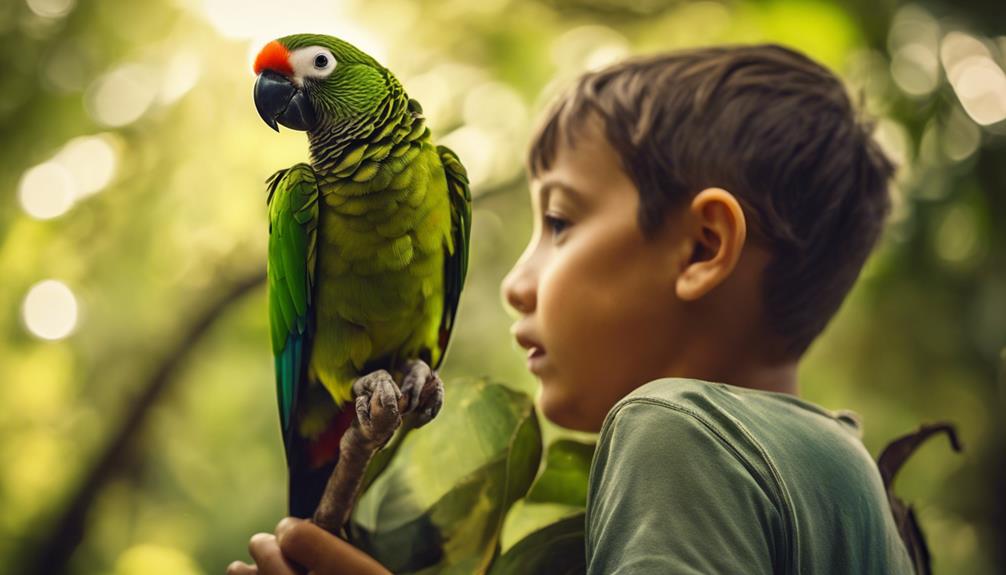
Senegal parrots make wonderful pets for families with kids because of their friendly and sociable nature. They are known for their playful temperament and ability to bond with their human family members.
When considering adopting a Senegal parrot for your family, it’s important to choose a time when you can dedicate sufficient time and attention to the bird. Senegal parrots thrive on social interaction and mental stimulation, so it’s essential to create a nurturing environment for them.
It’s recommended to adopt a Senegal parrot when your family has the time and energy to devote to building a strong bond with the bird. This will help ensure a happy and fulfilling relationship for both the parrot and your family.
Key Takeaways
- Consider adopting a Senegal Parrot when children are 8-10 years old for responsible interactions.
- Ensure seasonal adjustments for diet and safety measures to accommodate weather changes.
- Prioritize vet check-ups, safe home environments, and proper parrot handling for a harmonious coexistence.
- Supervise child-parrot interactions, establish clear rules, and teach respectful behavior for a positive bond.
Benefits of Adopting a Senegal Parrot
Adopting a Senegal parrot offers families with children the opportunity to cultivate responsibility, empathy, and patience through interactive companionship with these lively avian creatures. Like their larger African Grey relatives, Senegal parrots are known for their intelligence and ability to mimic speech. Understanding their body language can be a fascinating experience for kids, as it deepens their bond with these charming birds.
Senegal parrots are gentle and relatively quiet, making them ideal for households with children who may be sensitive to loud noises. These birds have a playful demeanor that can bring joy and laughter to the whole family. Moreover, their affectionate nature allows them to form strong connections with their human companions, providing emotional support and companionship, especially to kids.
Considerations for Families With Kids
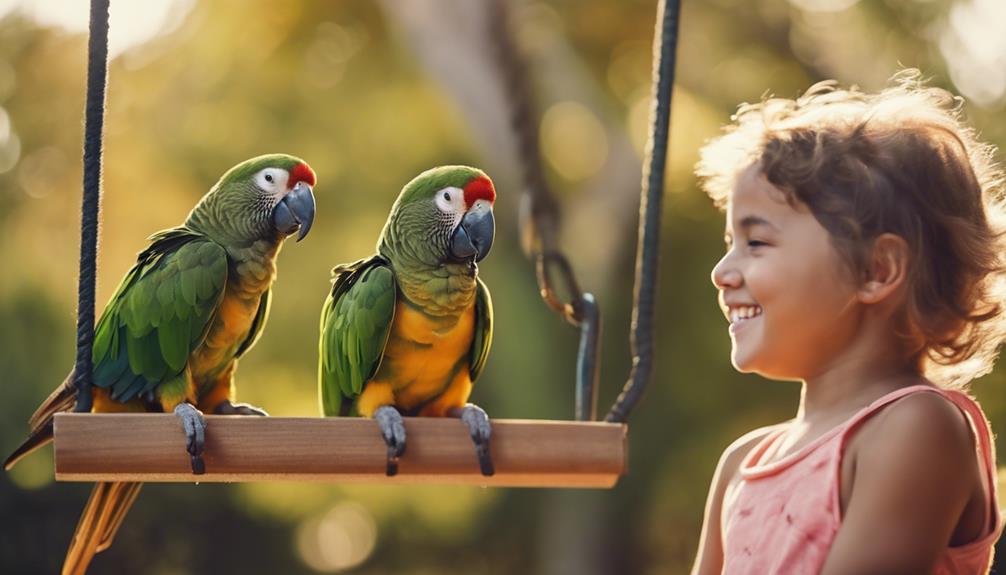
When considering adding a Senegal parrot to a household with children, it is essential to establish clear guidelines for safe and respectful interaction. Parental guidance is paramount in ensuring that children understand how to properly interact with the parrot. Supervision during interactions is crucial to prevent any mishaps and to safeguard the well-being of both the child and the bird. Household adjustments may be necessary to create a safe environment for the parrot and to set boundaries for children around the bird’s space. Engaging kids in the care and interaction with the Senegal parrot can be a rewarding experience, fostering a sense of responsibility and strengthening the bond between the child and the bird.
| Parental Guidance | Child Interaction | Household Adjustments |
|---|---|---|
| Set clear rules | Teach safe handling | Create safe spaces |
| Supervise closely | Encourage respect | Establish boundaries |
| Educate on parrot behavior | Avoid rough play | Provide appropriate perches |
Age of Kids to Introduce a Parrot
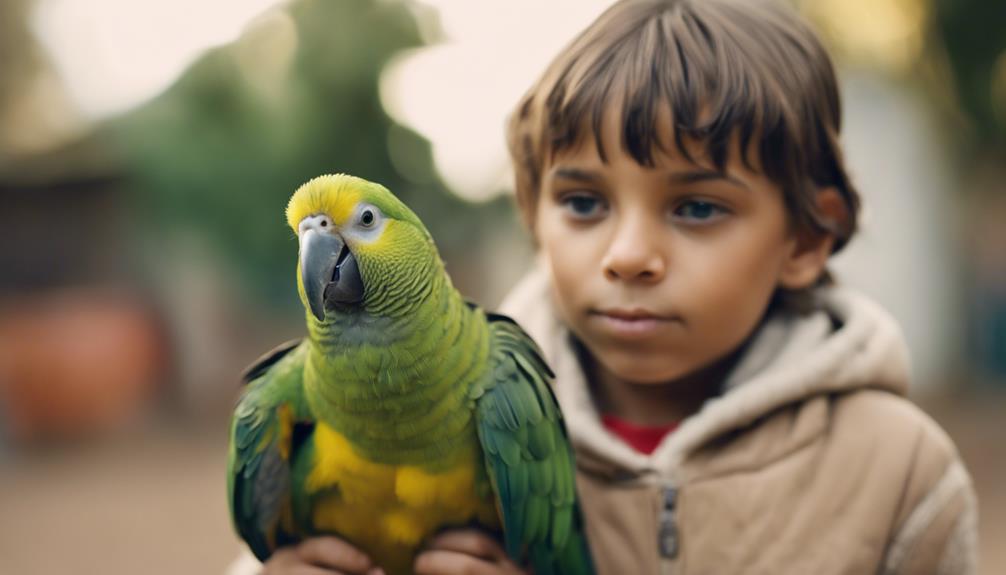
Children who are at least 8 years old are ideal for introducing a Senegal parrot due to their ability to understand responsibility. Safety measures, such as handling the parrot with care, are more likely to be followed by older kids.
Socialization between the parrot and children can be positive, fostering a bond under proper supervision.
Ideal Children’s Age
The recommended age for introducing a Senegal parrot to kids is typically between 8 to 10 years old, ensuring a balance of maturity and understanding for safe interaction. At this stage of child development, youngsters are more capable of grasping pet responsibilities and comprehending the nuances of parrot interaction.
Children within this age group can learn to respect the parrot’s boundaries, understand its needs, and actively participate in caring for and training the bird. While younger children may require closer supervision when interacting with a Senegal parrot, older kids are better equipped to establish a strong bond and mutual respect with the bird.
Introducing a parrot to children aged 8 to 10 sets the stage for a harmonious and enriching relationship between the child and the feathered companion.
Parrot Safety Measures
To ensure the safety and well-being of both the child and the Senegal parrot, introducing the bird to kids over the age of 8 is recommended. Here are some safety measures to consider:
- Training Techniques: Teach children proper handling methods to prevent stress or harm to the parrot.
- Safety Precautions: Establish guidelines for interacting with the parrot to avoid accidents and ensure a safe environment.
- Parrot Behavior: Educate kids on understanding the parrot’s body language and signals to promote a positive interaction.
- Child Interaction Dynamics: Supervise all interactions between the child and the parrot to foster a respectful and caring relationship.
Socialization With Kids
Introducing a Senegal parrot to youngsters aged 6 and above facilitates a more engaging and insightful bond between the bird and its young companions. At this age, children typically possess the necessary patience and gentleness required for handling and interacting with a parrot effectively.
It’s essential to teach kids appropriate playtime etiquette, communication skills, and understanding of behavioral cues when engaging with the parrot. Supervision during interactions is crucial to ensure both the safety of the children and the well-being of the parrot.
Encouraging gentle and respectful interactions through supervised play sessions can help foster a positive relationship between the parrot and children, leading to a fulfilling and enriching experience for both parties.
Seasonal Factors to Keep in Mind
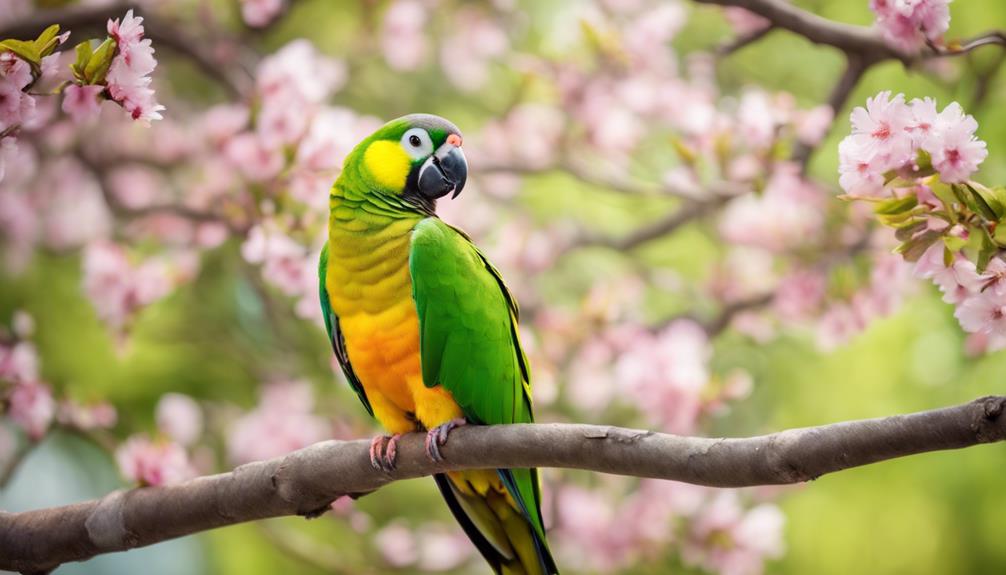
Consider the seasonal diet implications for your Senegal parrot, ensuring a varied and nutritious intake of fresh fruits and vegetables throughout the year.
Be mindful of how weather changes, particularly during the breeding season in spring, can influence your parrot’s behavior and mood.
Prioritize a health check beforehand to address any seasonal concerns and ensure your Senegal parrot’s well-being.
Seasonal Diet Considerations
Seasonal adjustments in fruit and vegetable availability are crucial for maintaining a varied and nutrient-rich diet for Senegal parrots. When considering seasonal diet for these birds, keep in mind the following:
- Nutritional Balance: Adjust the diet to ensure a balance of essential nutrients as fruit and vegetable availability changes.
- Food Variety: Introduce a variety of fruits and vegetables to meet the parrot’s dietary needs, considering the impact of weather on produce availability.
- Diet Diversity: Rotate different foods throughout the year to provide a diverse range of nutrients that cater to the parrot’s metabolic needs.
- Metabolic Needs: Be aware of how changes in temperature and activity levels during seasonal transitions can affect the parrot’s metabolism and adjust the diet accordingly.
Weather and Behavior
Senegal parrots’ behavior can be significantly influenced by seasonal weather patterns. Weather changes, such as cold temperatures, can lead to increased indoor time for these birds, affecting their usual activity levels.
During warmer months, Senegal parrots may exhibit higher energy levels and engage more in outdoor activities. Additionally, variations in humidity levels and air quality can impact the comfort and overall health of these birds.
It’s important for owners to be mindful of how changes in daylight hours can also affect the natural rhythms and behaviors of Senegal parrots. Understanding these behavioral adaptations to seasonal patterns can help create a comfortable and enriching environment for these intelligent birds.
Health Check Beforehand
Before bringing a Senegal parrot into your home, it’s essential to schedule a thorough vet check-up to ensure the bird’s health and well-being. Here are some seasonal factors to keep in mind:
- Dietary Requirements: Discuss with the vet any seasonal adjustments needed in the parrot’s diet to maintain optimal health.
- Behavioral Adjustments: Understand how seasonal changes may affect the parrot’s behavior and make necessary adaptations.
- Climate Considerations: Consider the impact of varying temperatures or weather patterns on the parrot’s well-being.
- Health Concerns: Check for specific seasonal health issues like respiratory problems in colder months and take preventive measures.
Taking these factors into account will help in providing the best care for your Senegal parrot throughout the year.
Preparing Your Home Environment
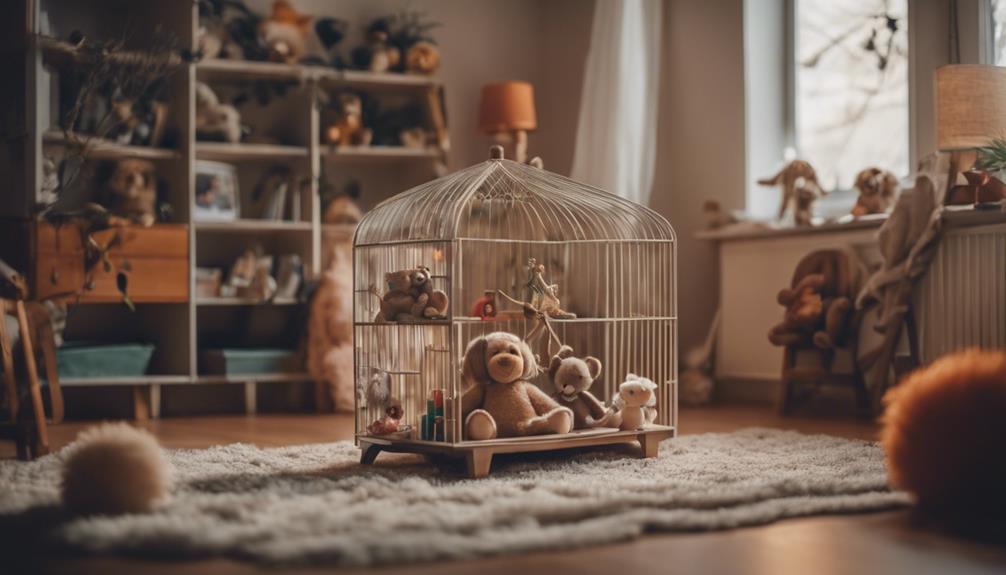
To create a safe and welcoming environment for your Senegal parrot, ensure that your home is thoroughly bird-proofed. This involves removing toxic plants, securing windows and doors, and hiding electrical cords that could pose a danger to your feathered friend. Providing a spacious cage with appropriate perches, toys, and food and water dishes is essential for the parrot’s well-being. Creating a designated area for the cage that is well-lit, draft-free, and away from household hazards will help your parrot feel secure. Additionally, it’s important to set up a comfortable and safe sleeping area for the parrot to rest undisturbed at night. Consider the noise level and activity in your home to ensure a calm environment for the parrot’s adjustment. Below is a table summarizing key points for preparing your home environment for your new Senegal parrot:
| Key Points | Details |
|---|---|
| Remove Toxic Plants | Ensure no harmful plants are accessible to your parrot. |
| Secure Windows and Doors | Prevent any potential escape or injury from open windows or doors. |
| Hide Electrical Cords | Keep cords out of reach to avoid electrocution hazards. |
| Provide Spacious Cage | Offer a cage with enough room for movement and play. |
| Create Safe Sleeping Area | Establish a cozy spot where the parrot can rest peacefully at night. |
Training Tips for a Smooth Transition

Training your new Senegal parrot for a smooth transition involves immediate engagement in positive reinforcement techniques to establish a strong bond. Here are some expert tips to help you with this process:
- Interactive Playtime: Incorporate daily play sessions where you engage with your parrot through toys, games, and social interaction. This helps build trust and strengthens your bond.
- Enrichment Activities: Provide your Senegal parrot with mental stimulation by introducing puzzles, foraging toys, and new experiences. This prevents boredom and encourages healthy behavior.
- Positive Reinforcement Techniques: Use rewards like treats, praise, or clicker training to reinforce good behavior. This method helps your parrot associate positive experiences with desired actions.
- Consistent Training Sessions: Establish a regular training routine to help your parrot learn commands like step-up and recall. Consistency and patience are key to helping your parrot adjust smoothly to its new environment.
Building a Strong Bond With Your Parrot
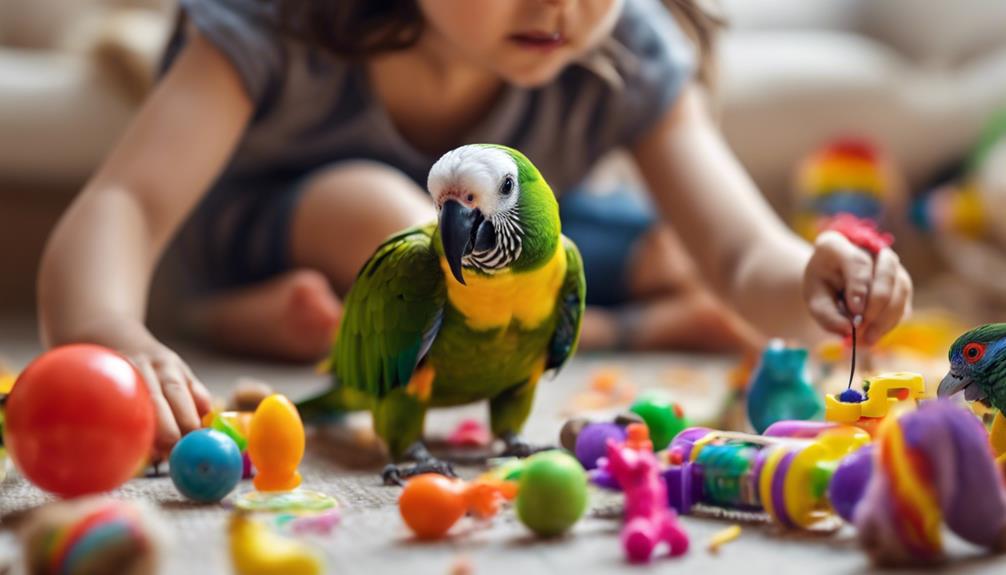
Establishing a strong bond with your Senegal parrot requires consistent quality time and engaging in interactive activities to foster trust and communication. Spending time outdoors with your parrot, whether in a secure outdoor aviary or harness training for supervised outdoor adventures, can be beneficial for bonding. Interactive games such as teaching new tricks, puzzle toys, or foraging activities not only provide mental stimulation but also strengthen the bond between you and your parrot.
Bonding activities like gentle scratches, soft talking, and sharing meals can help build trust and create a sense of companionship. Direct eye contact and positive reinforcement are essential in establishing communication and understanding each other. By observing and responding to your parrot’s body language, you can deepen your connection and enhance the bond.
Consistency in care, attention, and affection plays a vital role in nurturing a lasting and meaningful relationship with your Senegal parrot.
Frequently Asked Questions
Are Senegal Parrots Good With Kids?
Senegal parrots can be great companions for kids if trained and supervised properly. Building a positive bond with gentle interactions is key. Teaching children about the parrot’s boundaries and body language fosters a harmonious relationship.
What Is the Friendliest Parrot for Kids?
When considering the friendliest parrot for kids, parrot personalities play a crucial role. Senegal Parrots are known for their gentle demeanor, making them suitable companions for children. Proper training techniques and suitable habitats enhance their bond with kids.
What Is the Best Age to Buy a Parrot?
When considering the best age to bring home a parrot, focusing on the bird’s lifespan, behavior, and care needs is crucial. Young parrots, around 3 to 6 months old, offer a fresh start for training and bonding, setting a solid foundation for a lifelong relationship.
Are Senegal Birds Good for Beginners?
Senegal parrots are excellent for beginners due to their manageable size, ease of training, and ability to bond. They have a curious and playful nature that makes interactions enjoyable. Training tips, addressing behavioral challenges, and socialization techniques are crucial.











